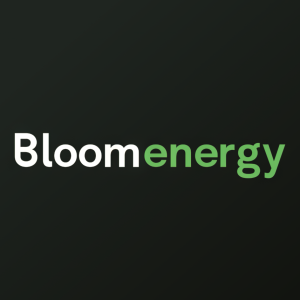Bloom Energy Announces Hydrogen Solid Oxide Fuel Cell with 60% Electrical Efficiency and 90% High Temperature Combined Heat and Power Efficiency
-
Highest electrical efficiency demonstrated on its Solid Oxide Fuel Cell (SOFC) platform when using
100% Hydrogen - Bloom’s fuel cell technology has demonstrated operations1 on both natural gas, hydrogen and on blends thereof making it future proof
- Negligible environmental pollutants like NOx emitted compared to reciprocating engines or turbines
Bloom engineers achieved the milestone efficiency at the company’s research and development facility in
“With our world-leading efficiency3 electrolyzer and the Bloom Energy fuel cell technology capable of running on natural gas and hydrogen blends, this achievement builds on our leadership position in the hydrogen industry,” said Ravi Prasher, chief technology officer for Bloom Energy.
Carbon-free hydrogen fuel cell for electricity production enables 24 X 7 clean power in conjunction with other renewable electricity sources4. As energy intensive industries like data centers and advanced manufacturing continue to place increased electricity demand on the grid, efficient distributed electricity production from carbon-free hydrogen is a vital tool to reduce both carbon emissions and strain on the congested grid.
Carbon-free hydrogen is generally more expensive than traditional sources of fuel, such as natural gas or grey hydrogen5, making high electrical efficiency critical to achieving low cost electricity. Bloom’s breakthrough electrical efficiency at
SOFC technology is uniquely placed in the energy transition through the production of electricity by direct electrochemical conversion as compared to conventional combustion technologies, such as turbines and reciprocating engines. This leads to significantly higher electric efficiency6 and negligible environmental pollutants7 as compared to the combustion technologies as shown in the table below.
In addition to offering unmatched electrical efficiency, Bloom’s high temperature SOFC technology is also Combined Heat and Power (CHP) enabled, allowing customers to utilize high temperature heat. This is in contrast to other fuel cell technologies8 which can only provide low temperature heat. Customers can use this high temperature heat in numerous applications, including running absorption chillers, industrial processes, and building heating. When fully utilized, this allows for a combined
The table below highlights the advantages of Bloom’s offering over traditional systems and other fuel cell technologies using hydrogen.
|
BE SOFC |
Other Fuel Cells PEM/PAFC |
Combustion Technologies |
Electrical Efficiency at full load1 |
High |
Medium |
Low |
Combined Heat and Power Efficiency |
High |
Medium |
Medium |
Heat Output Temperature |
High |
Low |
High |
Air Pollutants |
Negligible |
Negligible |
High |
*Efficiency is based on beginning of life operation
About Bloom Energy
Bloom Energy empowers businesses and communities to responsibly take charge of their energy. The company’s leading solid oxide platform for distributed generation of electricity and hydrogen is changing the future of energy. Fortune 100 companies around the world turn to Bloom Energy as a trusted partner to deliver lower carbon energy today and a net-zero future. For more information, visit www.bloomenergy.com.
Forward Looking Statements
This press release contains certain forward-looking statements, which are subject to the safe harbor provisions of the Private Securities Litigation Reform Act of 1995. Forward-looking statements generally relate to future events or our future financial or operating performance. In some cases, you can identify forward-looking statements because they contain words such as “anticipate,” “believe,” “could,” “estimate,” “expect,” “intend,” “may,” “should,” “will” and “would” or the negative of these words or similar terms or expressions that concern Bloom’s expectations, strategy, priorities, plans, or intentions. These forward-looking statements include adoption of hydrogen as a fuel source and advancement of the hydrogen economy. Readers are cautioned that these forward-looking statements are only predictions and may differ materially from actual future events or results due to a variety of factors including, but not limited to, risks and uncertainties detailed in Bloom’s SEC filings. More information on potential risks and uncertainties that may impact Bloom’s business are set forth in Bloom’s periodic reports filed with the SEC, including its Annual Report on Form 10-K for the year ended December 31, 2023, and its Quarterly Report on Form 10-Q for the quarter ended March 31, 2024, filed with the SEC on February 15, 2024, and May 9, 2024, respectively, as well as subsequent reports filed with or furnished to the SEC. Bloom assumes no obligation to, and does not intend to, update any such forward-looking statements.
1 https://www.bloomenergy.com/news/socalgas-and-bloom-energy-showcase-technology-to-power-hydrogen-economy-with-gas-blending-project/
2 Bloom Internal Engineering Data
3 https://www.bloomenergy.com/news/idaho-national-lab-and-bloom-energy-produce-hydrogen-at-record-setting-efficiencies/
4 https://www.sciencedirect.com/science/article/abs/pii/S0957582024001459
5 https://about.bnef.com/blog/green-hydrogen-to-undercut-gray-sibling-by-end-of-decade/
6 EPA: Analysis of Hydrogen in Combustion Turbine Electric Generating Units
7 https://netl.doe.gov/sites/default/files/publication/A-Literature-Review-of-Hydrogen-and-Natural-Gas-Turbines-081222.pdf
8 https://www.epa.gov/sites/default/files/2015-07/documents/catalog_of_chp_technologies_section_6._technology_characterization_-_fuel_cells.pdf
View source version on businesswire.com: https://www.businesswire.com/news/home/20240805342400/en/
Media
press@bloomenergy.com
Investors
Ed
investor@bloomenergy.com
Source: Bloom Energy








